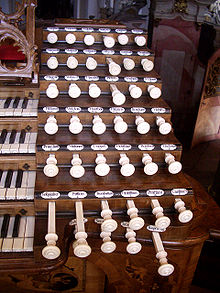stop
The stop (. Manubrium also, Pl Manubrien; lat = handle, handle, arm.) Is the oldest construction of an on / off switch for a single register an organ . These classic handles are mainly found in mechanical stop action , and are artfully turned, especially on old organs, and made of special wood. (The registers of the Gabler organ in Weingarten are even made entirely of solid ivory) registers are usually found on both sides of the manuals, with historical organs also above the music desk on the console and are operated by the organist or registrant . Organs whose registers are moved horizontally are less common. On organs with a mechanical spring drawer , the stops must be hooked into the end position. With slider drawer instruments , it is also possible to only partially pull out the stops and thus achieve special sound effects, since the bores of the loops do not completely clear the way for the play wind (the air for the pipes). Due to the mechanical requirements, stop slides usually look very similar and are the first things most people associate with the terms organ and stop. The signs for the register lettering can be placed next to the register lines or, mostly as a round porcelain medallion, attached to the front side. In addition, color coding or different types of wood, e.g. B. specify the affiliation of the register to a work or the affiliation of the register to the family of reed pipes. Nowadays it is also possible to engrave the front of a register with the desired text. Material, lettering, color coding and arrangement of the registers are not standardized, they differ depending on the organ building workshop. In the case of an organ with a double action mechanism (electromagnetic stop control hooked into the mechanical stop action), the stop slides are automatically moved into the correct position , for example when a combination is called up; in addition, with purely electrical stop action mechanisms there are also self-adjusting stop switches which only copy the classic form of the stop action (especially very common in large American organs; draw knobs console) and have no mechanical function.
See also
Individual evidence
- ↑ Christoph Krummacher: ways to the organ. Evangelische Verlagsanstalt, Berlin 1987, ISBN 3-374-00178-5 , p. 32.
- ↑ Johann Gottlob Töpfer , Paul Smeets: Textbook of organ building art. Volume 2, Rheingoldverlag, Mainz 1957, p. 265 ff.


